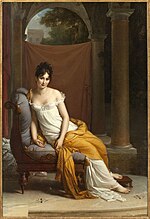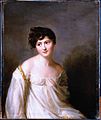Juliette Récamier
Juliette Récamier | |
|---|---|
Salonnière | |
| Spouse | |
Jeanne Françoise Julie Adélaïde Récamier (French pronunciation:
Family and education
A native of Lyon, she was the only child of notary and King's counsellor Jean Bernard and his wife, the former Julie Matton. In 1784, her father was named receiver of finance under Calonne. She was briefly educated at the Couvent de la Déserte in Lyon, until her family moved to Paris. The name "Juliette" came about as a diminutive of "Julie".[3] Beautiful, accomplished, and possessing a love of literature, Récamier was described as shy and modest by nature.[1]
Early marriage
At the age of fifteen, she was married on 24 April 1793 to
I am not in love with her, but I feel for her a genuine and tender attachment which convinces me that this interesting creature will be a partner who will ensure the happiness of my whole life and, judging by my own desire to ensure her happiness, of which I can see she is absolutely convinced, I have no doubt that the benefit will be reciprocal .... She possesses germs of virtue and principle such as are seldom seen so highly developed at so early an age; she is tender-hearted, affectionate, charitable and kind, beloved in her home-circle and by all who know her.[4]

A rumour arose that her husband was, in fact, her natural father who married her to make her his heir.[2] Their marriage occurred at the height of the revolutionary terror and, if he were guillotined, she would inherit his money. Although many biographers have given credence to this theory, it is unproven[5] and discounted by several historians.[6] Curiously, however, Jacques once wrote to a friend that his relations with Madame Bernard may have been more than platonic:
It may be said that my feelings for the daughter arise out of those I have had for her mother; but all those who frequent the house are well aware that what took me there was pure friendship, a friendship which had grown out of the possibly somewhat warmer feeling I may have had in the earlier days of our acquaintance. At present, having reached an age when all other pretensions are past, she only wishes to educate her child, and make her a virtuous and good woman.[7]
The marriage was never consummated, and Récamier remained a virgin until at least the age of forty.[8] A rumour was initiated by writer Prosper Mérimée[5] that she suffered from a physical condition which made the act of sexual intercourse painful.[6] This, however, did not inhibit her charm, as many individuals including François-René de Chateaubriand were said to have had intense emotional relationships with her. Chateaubriand was a constant visitor of her salon and, in a manner, master of the house.[2]
European celebrity

From the earliest days of the
It was through Germaine de Staël that Récamier became acquainted with Benjamin Constant, a Swiss-French political activist and writer, whose political equivocations during the last days of the First French Empire and the first of the Bourbon Restoration have been attributed to her persuasions.[1] She was eventually exiled from Paris by the orders of Napoleon.[2] After a short stay at her native Lyon, she proceeded to Rome, and finally to Naples. There she was on exceedingly good terms with Joachim Murat and his wife Caroline Bonaparte, who were then intriguing with the Bourbons.[1] She persuaded Constant to plead the claims of Murat in a memorandum addressed to the Congress of Vienna, and also induced him to take up a decided attitude in opposition to Napoleon's return during the Hundred Days.[1]
Later years

Récamier's husband had sustained heavy financial losses in 1805, and she visited Germaine de Staël at Coppet in Switzerland.[9] There was a project for her divorce, in order that she might marry Prince Augustus of Prussia, but, though her husband was willing, it was not arranged.[2] In her later days she lost most of what was left of her fortune; but she continued to receive visitors in her apartment at Abbaye-aux-Bois,[2][10] a 17th-century convent (demolished in 1907) situated at 16 rue de Sèvres in Paris, to which she retired in 1819.
Despite old age, ill-health, partial blindness, and reduced circumstances, Récamier never lost her attractiveness, though at least one man who met her, artist
In 1849, Récamier died in Paris of
Cultural legacy
A type of sofa or chaise longue on which she liked to recline, the récamier, was named after her.[2]
She was the subject of two silent films. A 1920 German film Madame Récamier starring Fern Andra and a 1928 French film Madame Récamier.
Gallery
-
Portrait by Jean-Baptiste Augustin (1801)
-
Portrait by François Gérard (1805)
-
Canvas by Firmin Massot (1807)
-
Portrait of Madame Récamier by Antoine-Jean Gros (1825)
-
Portrait by François-Louis Dejuinne (1827)
-
Crayon noir by François Gérard (1829)
See also
- Jean Anthelme Brillat-Savarin
- Germaine de Stael
- Francois-Rene de Chateaubriand
- Jacques-Louis David
- Francois, Baron Gerard
- Jacques-Rose Recamier
- Prince Augustus of Prussia
References
- ^ a b c d e f g h i Chisholm, Hugh, ed. (1911). . Encyclopædia Britannica (11th ed.). Cambridge University Press.
- ^ a b c d e f g "Juliette Récamier, the Darling of Europe". The Guardian. 18 May 2009. Retrieved 3 October 2018.
- ^ Edouard Herriot, Madame Récamier, pp. 1–2
- ^ Edouard Herriot, Madame Récamier, p. 12
- ^ ISBN 0-300-07421-2
- ^ ISBN 0-8021-3837-3
- ^ Edouard Herriot, Madame Récamier, p. 13
- ISBN 0-8021-3837-3
- ISBN 0-8021-3837-3
- ^ "L'Abbaye aux Bois". lartnouveau.com.
The Abbaye aux Bois Couvent Bernardines was located at 16, rue de Sèvres opposite the hotel Lutécia. The Abbey was created in 1202, the convent removed in 1792 the buildings become a prison in terror, the monastery was destroyed in 1907 during the expansion of the rue de Sèvres. Rue Récamier and Roger-Stéphane Square were then created.
- ^ Edmond and Jules de Goncourt, ed. and trans. Lewis Galantière. The Goncourt Journals (Doubleday, 1937), p. 23.
- S2CID 147148461.
- ^ "Récamier, Juliette (1777–1849)". Women in World History. Gale. 2002.
- ^ "Map of Montmatre Cemetery". Paris City Hall. Archived from the original (PDF) on 17 March 2017. Retrieved 24 April 2019.
Bibliography
- Levaillant, M. (1958). The Passionate Exiles: Madame de Stael and Madame Recamier (M. Barnes, trans.). Farrar, Straus, & Cudahy. 1958.[1]
- Hillman, S. (2018). Gilt by Association: The Collaborative Celebrity of Germaine de Stael and Juliette Recamier. Journal of Women's History 30(1), 56–79.[2]
- Joseph-Marie, Baron de Gerando. (1868). Lettres Inedites et Souvenirs Biographiques de Mme Recamier et Mme de Stael. Jules Renouard.[3]
- Wolfgang, A. (1999). A Passion Between Two Women: The Case of Germaine de Stael and Madame Recamier. Women in French Studies 7, 66–78.[4]
- Lenormant, Amelie. Souvenirs et correspondances tirés des papiers de Madame Récamier (1859)
- Amélie Lenormant, Madame Récamier, les amis de sa jeunesse et sa correspondance intime (1872)
- Mary Elizabeth Mohl, Madame Récamier, with a sketch of the history of society in France (1821 and 1862)
- Revue des deux mondes(December 1859 and February 1873)
- H. Noel Williams, Madame Récamier, and her Friends (London, 1901)
- Édouard Herriot (Engl. trans., by Alys Hallard), Madame Récamier et ses amis (1904)
- This article incorporates text from a publication now in the public domain: Chisholm, Hugh, ed. (1911). "Récamier, Jeanne Françoise Julie Adélaïde". Encyclopædia Britannica (11th ed.). Cambridge University Press.
External links
- Works by Juliette Récamier at Project Gutenberg
- Works by or about Juliette Récamier at Internet Archive
- ISBN 9780836980868.
- S2CID 150101095.
- ^ Récamier, Jeanne Françoise Julie Adélaïde Bernard (1868). Lettres inédites et souvenirs biographiques de Mme Récamier & de Mme de Staël (in French). Ve Jules Renouard.
- S2CID 147148461.






